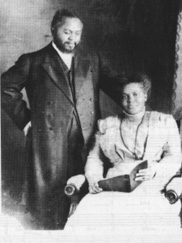A Charismatic Looks at the Birth of Pentecostalism
After the LA Times articles the crowds increased to about 200-300 per evening. The initial revival at Azusa Street lasted between 1906-1909, with another burst occurring after 1911. Besides bringing thousands of skeptics and non-believers to the Lord, many thousands were Baptized in the Spirit, and many healed. But, the major work of the revival was to broadcast the “Pentecostal package” of Holiness sanctification, Baptism of the Spirit with tongues, divine healing, Faith-Idealism, and premillennialism. Eventually Seymour deemphasized tongues as “initial evidence” and stressed tongues and the Baptism of the Holy Spirit for empowerment in service, but not before Parham’s original doctrine of initial evidence became the majority view among the newly forming Pentecostal churches.
Faith-Idealism was an integral part of this package, though most often lived rather than preached. We catch a glimpse of it from Bartleman’s own comments on an attack of mumps as he spread the word of Pentecost through the south: “The mumps were working on me, though I refused to acknowledge it.”[23]
Besides the many visitors to the Azusa Street mission, Pentecostalism spread through the wide circulation of Seymour’s newspaper, The Apostolic Faith. He directed the paper and wrote many of its articles. Seymour had the help of two female employees on the Azusa Street Mission staff, Miss Clara Lum, and Mrs. Florence Reed Crawford.[24] Miss Lum had experience as an editor of a missionary journal, and Mrs. Reed Crawford, was also experienced in Christian publishing. Mrs. Reed Crawford also served as Pentecostal apostle and evangelist for California. The Apostolic Faith’s first printing in 1906 numbered 5,000 copies, a substantial figure for the times. It grew to 40,000 by 1907 – fed by a mailing list of visitors from the United States and overseas which was managed by Miss Lum. It was of critical importance in spreading the “Pentecostal Package” in the initial years of the revival.

William and Jenny Seymour.
What ultimately happened to Seymour and his paper is a tragedy of Shakespearian proportions. Seymour and his staff, like many Holiness revivalist of his times, were absolutely certain of the very soon return of Jesus Christ – as in next week, or at most a few years. However Seymour had a romantic interest in Miss Lum, a white woman, and considered marrying her. He consulted with his church board which advised him that such an interracial marriage would destroy the budding revival (this was 1907, not 2007). Seymour stopped that romance.
At bit later he fell in love and married Jenny Moore (1908) – a very attractive Black woman. Before his marriage to Moore, Seymour began preaching that marriage was OK in spite of the imminent return of Jesus Christ. This was disappointing to both Miss Lum and Mrs. Crawford who considered Seymour’s marriage a scandal and violation of Paul’s admonition not to marry because the “time is short” (1 Cor. 7). With indignation (and jealously?) two of the women ran off with The Apostolic Faith mailing list to Portland, Oregon.[25] They continued printing the The Apostolic Faith from Portland without even letting the readers know that Seymour was no longer in charge. Mrs. Crawford went on to found a separate Pentecostal denomination called the Apostolic Faith Mission, and she made sure that none of her ministers married.[26]
The theft of the mailing list cut off Seymour from his national following and short-circuited his continued leadership in the Pentecostal Movement. His church, The Azusa Street Mission, lingered on as an African American Pentecostal church with small numbers until his death in 1922. It would go on under the pastorship of his widow, Jenny, until 1931 when she retired.
Early Pentecostals’ confusion of tongues with being able to speak unlearned foreign languages was a major cause of its ridicule and rejection by the majority of Evangelicals.
Category: Church History, Fall 2014


